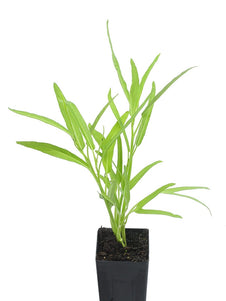
Kang Kong (Water Spinach)
Kang Kong (Water Spinach)
- In stock, ready to ship
- Inventory on the way

Usually available: September to April
Life cycle: Tender Perennial
Height: 3m vine
Position: Full sun
Soil preference: Moist
This is how we pack and send your Herb Plants to all states except TAS & WA
You will receive
- 1 Kang Kong Herb Plant in a 50 X 75mm tube - General growing instructions
All of our Herb Plants are grown organically with certified organic potting mixes and fertilizers
Botanical Name: Ipomea aquatica
Kang Kong is an herbaceous trailing vine with a semi-aquatic habit. It has long hollow stems that help it to float when growing in water. The stems help keep the leaves above the surface and the plant continues to root at the nodes. The alternately positioned leaves are from 5-15cm long and arrow shaped, or lanceolate. They may be from 2-8cm wide and held on the trailing stems, which may be 2-3 meters long. The leaves are green but may have a purple blush that varies depending on the individual plant. The white to pink-lilac flowers are trumpet shaped with a mauve centre and are from 3-5 cm in diameter. The seed pods are oval shaped and house 1-4 grey seeds.
The native habitat of Kang Kong extends across South East Asia, but is common in many tropical and sub-tropical regions of the world. In India, for example, Kang Kong grows in and around natural and man-made water courses. Canals, rivers, ponds, paddy fields and streams and the damp land around them provide ideal habitat. A side effect of this is that the plant may grow in polluted water sources, which affects locals who harvest and consume the plant directly.
Kang Kong (Ipomoea aquatica) belongs to the Convolvulaceae family, which has over 500 species of flowering plants. Common names include water spinach, swamp cabbage, or Chinese Spinach. It is known by many names all over the world. It also goes by the name Water Morning Glory, Kang Kung and has other botanical synonyms. You may find it referenced as Convolvulus repens – Vahl, Ipomoea –Vespers Roth, and Ipomoea reptans – Poiret.
Growing Conditions
Kang Kong is a both easy and fast to grow. A sunny and bright location should be paired with damp or moist soil for best results. Alternatively, a water bowl, barrel or permanent water supply will do nicely. Mesh should be placed in the container near the surface to support the leaves and stems. In natural water courses, where plants can spread, the leaves are held above the water’s surface by the hollow and buoyant stems. Under the right conditions, Kang Kong can provide a supply of nutritious leafy greens all year round. The plant will benefit from the use of liquid fertiliser.
In its natural habitat Kang Kong can form spreading, floating mats in streams and river courses and often block passage of the local boats. Show caution when disposing of cuttings as Kang Kong can spread very easily under the right circumstances. For example, this plant presents an environmental problem in Florida and Texas where it is introduced.
Medicinal Uses
Kang Kong has a long history of traditional medicine use, with the stems being determined as more potent than the leaves. The plant is rich in minerals such as calcium and iron, and contains sodium, magnesium, phosphorous, manganese, copper and zinc. Vitamin B2, C and K are also present. Further active ingredients include flavonoids, catechin and phenolic compounds, so there is powerful antioxidant activity. Research has indicated that there is significant medicinal value in the Kang Kong plant, with studies on cholesterol and diabetic treatments being explored.
In Ayurveda Medicine, it is used to treat jaundice and liver problems. The leaves are used to treat diabetes in pregnant women and it is also used as a sedative to promote sleep and relaxation.
Culinary Uses
Kang Kong has many culinary uses and there are recipes available from all over South East Asia. This plant is used extensively in Burmese, Thai, Lao, Cambodian, Taiwanese, Malaysian, Vietnamese and Chinese cooking. Although the plant grows naturally some areas of China and South East Asian cultivate the plant for commercial use and sale in local markets.
Kang Kong may be used in the same way as spinach and other Asian greens by including the leaves in salads, stir fry dishes and vegetable dishes. For example, the leaves may be cooked in olive oil for a few minutes and combined with garlic and chilli. Harvest the young leaf tips, or use with the stems as an alternative green leafy vegetable. The leaves have a mild flavour and may be eaten raw or cooked.
All information provided on this website is for informational purposes only. Please seek professional advice before commencing any treatment.




